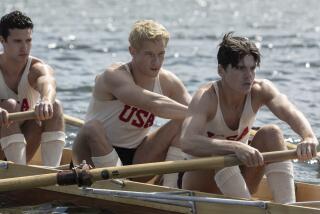America’s Cup: Huge egos, fast boats
- Share via
Larry Ellison, prince of Silicon Valley, is richer than God. But even Ellison can’t always get what he wants.
FOR THE RECORD:
America’s Cup: An Op-Ed Tuesday about the sailing race said Team USA’s score after four races in the final series was 1. In fact, it was -1.
In 2010, Ellison’s Oracle Team USA won the America’s Cup, the 162-year-old yacht race that pits big personalities and big pocketbooks against wind, currents and radical boat design. The victory gave him the right to set the rules for where and how the next cup would unfold. He chose San Francisco Bay as the location, and set specs for the boats: They would be seven-ton catamarans, 72 feet long, with 13-story carbon-fiber fixed “wingsails.” When these so-called AC 72s get going — their top speed is upward of 40 knots, or 50 mph — they jump out of the water like planes lifting off. They fly.
Ellison isn’t humble. He says he wants his version of the cup to jerk yacht racing into the 21st century, with risky sailing, extreme speeds and high-tech coverage (Ellison has bankrolled TV time and an impressive digital tracking system to help the uninitiated follow the action). He wants you, me and the guy who gets seasick on the ferry to Catalina to care about the America’s Cup.
But things haven’t been going all that well for the race, which headed into its final round Saturday, as Oracle Team USA began its defense of the trophy against the top challenger, New Zealand.
The bad news started well before the first races this summer. In October, Oracle’s boat “pitchpoled,” capsizing spectacularly on a trial run in high winds. As the soggy crew watched from chase boats, the current swept $8 million to $10 million worth of AC 72 out the Golden Gate (parts of it were towed back to San Francisco’s Embarcadero to be rebuilt). A few months later, tragically, Artemis Racing, the Swedish challenging team, lost control of its AC 72, and this time one of the world’s best sailors, British Olympic gold medalist Andrew “Bart” Simpson, was trapped in the wreckage and drowned.
The backlash was as swift as the boats: This was a race of egos, not yachts. AC 72s were too fast, too fragile, too hard to control. Ellison’s arrogance was going to kill the cup.
Everyone agreed the boats were way too pricey. Exactly how much it costs to get a crew and an AC 72 (or two) up and running isn’t posted anywhere obvious on the cup website, but estimates put the price tag at $50 million to $120 million. That’s a lot of money for a small chance at bragging rights to a silver urn. Fifteen syndicates were supposed to vie for the right to challenge Oracle in the finals; all but three looked at the cost and said no.
One of those three — Emirates Team New Zealand (Kiwi-sponsored, with Emirates Airlines funding) — dominated in the Louis Vuitton Cup, the challengers’ elimination races in July in San Francisco. New Zealand has mastered and tweaked its AC 72s. (In fact, the New Zealanders were the first to discover that a boat built to Ellison’s specs could fly, or “foil” — short for “hydrofoil” — under the right circumstances.) The team’s skill (and its fast boat) along with a sorry lack of competition made the Vuitton Cup a ho-hum affair. If New Zealand crossed the finished line, New Zealand won.
Ho-hum wasn’t supposed to be part of the bargain, not for Ellison or San Francisco, which handed over a chunk of prime waterfront to the cup organization amid gamesmanship, lawsuits and general NIMBY outrage. The city had visions of 2.7 million visitors, 9,000 jobs and a $1.4-billion payday. It has now scaled back those hopes by about a third, and some doubt that the money it fronted the cup organizers will be repaid in full.
And those aren’t the only lowered expectations. Starting in 2011, the organizing committee sponsored an America’s Cup World Series — races at ports around the world featuring potential cup contenders. For these races, teams used 45-foot versions of the AC 72s. As it turns out, the Oracle team cheated in the series, adding weight to its AC 45s. When the funny business was uncovered in August, Team USA apologized and gave back its trophies. But the International Sailing Federation jury wasn’t mollified. Days before the final races began, the jury fined the team two points in the final round and sidelined four of its crew. Oracle had to begin the best-of-17 finals in the hole and with an ugly little asterisk next to its name.
Epic failure, right? It’s easy, even satisfying, to boo Ellison and his grandiose America’s Cup vision. Yes, he ordered up the outrageous, expensive AC 72s. Yes, he craved risk and speed, and Simpson died. And yes, his team “mistakenly” attached extra baggies of resin and lead weights to their AC 45s. But Ellison hasn’t killed the cup, at least not yet.
Truth is, it may be impossible for overreach, ego or even tragedy to kill the America’s Cup. Its long history is replete with danger, plutocrats, weasel moves, finger-pointing and controversy. And when it comes to cup craziness, as one longtime sailor told the San Francisco Chronicle, there have been “personalities that make Ellison look like a piker.”
Over the weekend, Ellison’s team got soaked. It lost three of four weekend races; then, in the last go-round Sunday, it grabbed a fragile lead and held it. The score is Kiwis 3, USA 1, and the next races are Tuesday. So far, the 2013 America’s Cup has been one ugly regatta, but when its monster boats cross with a foot to spare, accelerating into thin air, it’s also been one nifty leap in the never-ending quest to get somewhere fast, and win a trophy doing it.
Susan Brenneman, deputy Op-Ed editor, served as ballast in several minor sailing races on San Francisco Bay.
More to Read
A cure for the common opinion
Get thought-provoking perspectives with our weekly newsletter.
You may occasionally receive promotional content from the Los Angeles Times.











